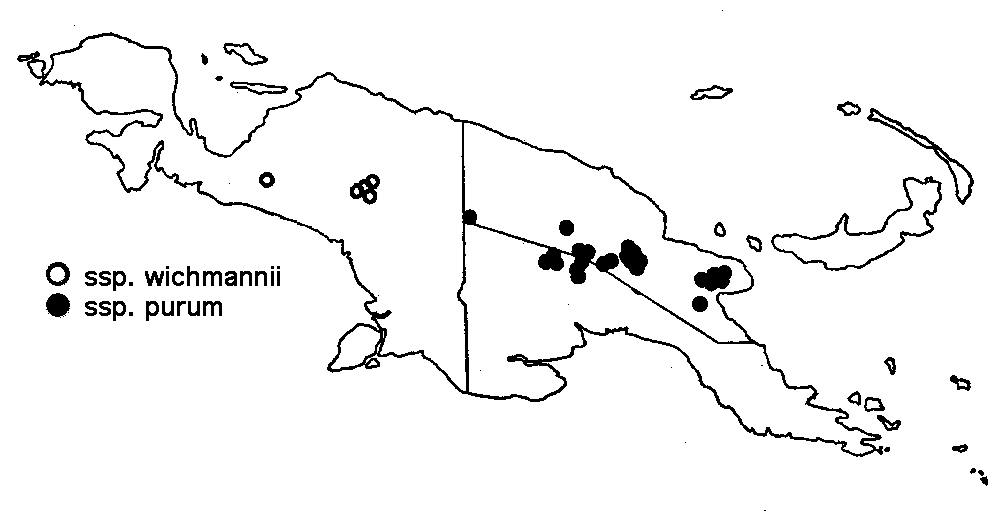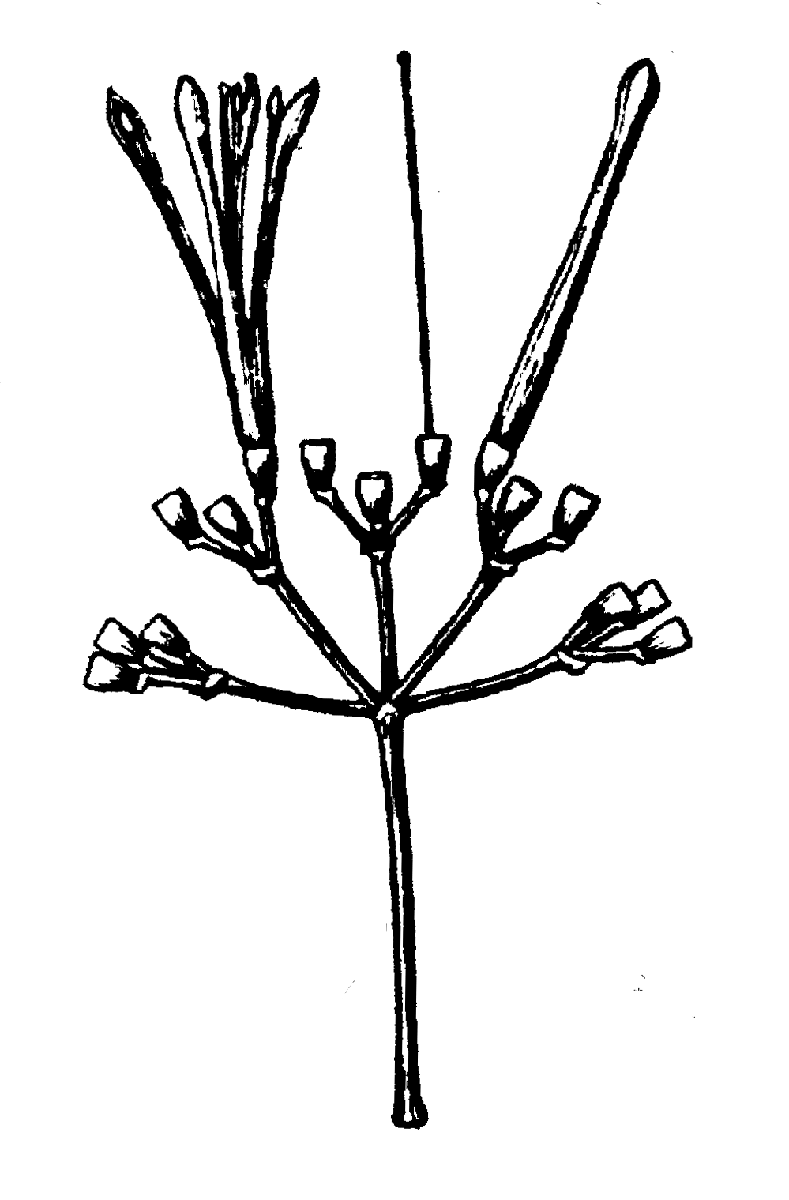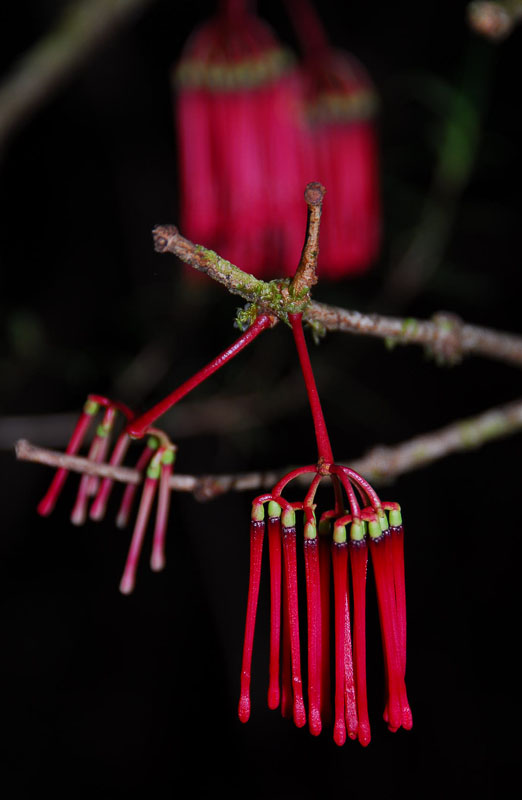
Distribution Map

Description (Barlow 1992)
Loranthus wichmannii Krause, Bot. Jahrb. Syst. 57 (1922) 465. - Amyema wichmannii (Krause) Danser, Bull. Jard. Bot. Buitenzorg III, 10 (1929) 299. - Type: Pulle 979 (lecto L, see below; iso L), New Guinea, Wichmann Mts, 2900 m, 28.i.l913.
For descriptions see Danser, Bull. Jard. Bot. Buitenzorg III,
11 (1931) 354; Barlow, Austral. J. Bot. 22 (1974) 596. Additional
synonymy is unchanged other than the transfer of A. wichmannii
subsp. aggregata to A. artensis (see below).
Amyema wichmannii can be identified locally by its combination
of opposite bifacialleaves, its umbel of triads with a long peduncle
dilated at the apex and bearing 6-12 rays, and 4-merous flowers.
The flower colour is described as red in various shades, and often
so dark in the lower part as to appear black.
The species occurs in the highlands of New Guinea (fig. 16; 76
collections seen), common in subalpine vegetation from Wissel
Lakes to Mt Amungwiwa, mostly at elevations from 2750 to 3600
m, rarely down to 2000 m and up to 4025 m. Recorded hosts include
Ardisia, Drimys, Eurya, Rapanea, Rhododendron, and Vaccinium.
The subalpine species of Amyema
in New Guinea are a closely related natural group of apparently
young species. Geographic and altitudinal replacement patterns
exist, and intergradation between some of the species occurs.
Amyema wichmannii has apparently hybridized in the recent
past with A. dilatipes (see notes there). Amyema wichmannii
has similar habitat requirements to A. pachypus, and
they have a geographic replacement pattern along the New Guinean
mountain axis. The two species have probably differentiated ecogeographically.
Barlow (1974) distinguished three subspecies in A. wichmannii,
with relatively discrete areas in New Guinea. The present
study has shown that the specimen from the highlands of the Milne
Bay District on which subsp. aggregata was based is probably
misplaced. Along with several other additional specimens seen
from that area, distinctive in having 4 or 5 rays in the umbel,
it is probably a local extreme of variation in A. artensis
and not a disjunct subspecies of A. wichmannii. See
note under A. artensis. After examination of all the materials
available for the present study the status of the other two subspecies,
wichmannii and pura Barlow, is confirmed. They have
a geographic replacement pattern, with a contact zone in the Star
Mountains near the Papua New Guinean border with Irian Jaya. The
observed gradation between them is steep, indicating that the
gene pools represented by the subspecies have considerable integrity.
For further discussion of the subspecies see Barlow (1974).
Description (Barlow 1974)
Amyema wichmannii (Krause) Dans. Bull. Jard. bot. Buitenz. 10: 299 (1929); 11: 354, illus. Fig. 11, o (1931); Loranthus wichmannii Krause, Bot. Jahrb. 57: 465 (1922). Type-New Guinea, Wichmann Mountains, 2400 m alt., Pulle 979, 28.i.1913 (B, holotype, not seen, probably destroyed; L 926134897). Loranthus keysseri Krause, Bot. Jahrb. 62: 474 (1929). Type.-New Guinea, Bolan, Saruwaged Mountains, 3400-3800 m alt., Keysser sn., 1913 (BM, photo in AD).
Glabrous except for a few cilia on the bract. Stems slightly flattened when very young, soon becoming terete. Leaves opposite; petiole 2-8 mm long, terete or slightly flattened above; lamina very variable, broad lanceolate to nearly orbicular, (1.7)-4-l0 by (1)-2-4 cm, lustrous above, dull below, attenuate to contracted at the base, finely undulate and sometimes minutely serrate at the margin, usually acute or obtuse with a small mucro but often rounded at the apex; venation pennate with the venation usually obscure. Inflorescences solitary (or 2) in the axils; peduncle 0.7-1.3 mm wide near the base, dilated to l-2-(3) mm wide at the apex, (18)-22-32- (45) mm long; rays 9-(12), slightly to strongly divergent, slightly thinner than the peduncle, (4)-6-l0 mm long; pedicels of the lateral flowers of the triads (1.5)-2-5 mm long, slightly to strongly divergent, more or less cigar-shaped; bracts acute, usually with a rounded dorsal protuberance, c. 1 mm long. Calyx barrel-shaped or rarely nearly cylindrical; limb 0.2-0.5 mm long, minutely toothed. Corolla in the mature bud slender, strongly clavate, acute or rounded at the apex, (13)-20-28-(32) mm long, 4-merous. Anthers 1-2 mm long; free parts of the filaments 1-4 mm long. Stigma about twice as wide as the style. Fruit barrel-shaped to nearly spherical, c. 5 mm long.
Occurrence. New Guinean highlands (Fig. 6), usually 2750 to 3450 m altitude but recorded down to 2350 m alt. Common in alpine and subalpine communities within its geographical area.
Amyema wichmannii is
probably the most widespread and common of the mistletoe species
that occur at high elevations in New Guinea. It is closely related
to A. pachypus, A. corniculatum and A. clavipes, differing
primarily in having more rays in the umbel. It is also probably
closely related to A. dilatipes, as two putative
hybrids between A. wichmannii and A. dilatipes have
been seen (see note under Hybridization). All of these species
are presumably geographical or altitudinal segregates of a single
complex.
The three rather distinct morphological forms of A.
wichmannii have contiguous geographic areas,
and have been treated as subspecies.
Key to Subspecies of Amyema wichmannii
1. Leaves spotted below. Central flower of
the triad usually on a pedicel 2-4 mm long 29a. Subsp. wichmannii
1. Leaves not spotted below. Central
flower of the triad sessile 2
2. Calyx limb c. 0.2 mm long. Pedicels of the lateral flowers
6-10 mm long. Rays of the umbel mostly 6 or more 29b. Subsp. purum
2. Calyx limb c. 0.5 mm long.
Pedicels of the lateral flowers c. 4 mm long. Rays of the
umbel 5 29c. Subsp.
aggregatum
29a. Subsp. wichmannii
Leaves spotted below. Central flower of the triad usually on a pedicel 2-4 mm long.
Occurrence. West Irian, from Wissel Lakes to Lake Habbema (Fig. 6).
Specimens Examined. WEST IRIAN: Slope and summit, Mt. Moetaro, Wissel Lakes region, Eyma 5201, 9.ix.1939 (L); 18 km NE. of L. Habbema, 2350 m alt., Brass 11298, Nov. 1938 (CANB); 9 km NE. of L. Habbema, 2800 m alt., Brass 10638 and 10803, Oct. 1938 (CANB); Lake Habbema, 3225 m alt., Brass 9361, Aug. 1938 (CANB).
29b. Subsp. purum Barlow, subsp. nov.
Type-New Guinea, Mt. Wilhelm, E. slopes, 2770 m alt., Brass 30674, 23.vii.1959 (L 96184406, holotype; CANB 101105; K).
Loranthus keysseri Krause.
Lamina non maculosa infra. Flos centralis triadi
sessilis. Radii umbellae (5)-6-9-(12). Pedicelli forum lateralium
6-10 mm longi. Limbus calycis 0.2 mm longus.
Lamina not spotted below. Inflorescence rays mostly 6 or more;
central flower of the triad sessile; pedicels of the lateral flowers
6-10 mm long. Calyx limb c. 0.2 mm long.
Occurrence. Eastern New Guinean highlands, from the Star Mountains to Salawaket Ra. (Fig. 6).
Representative Specimens. EASTERN NEW GUINEA: Sirius Ridge, Telefomin Subdist., 3060 m alt., Craig 94, l5.iv.1965 (LAE); western summit grasslands of Mt. Giluwe, c. 3060 m alt., Schodde 1853, l5.viii.1961 (CANB; L); Mt. Wilhelm, E. slopes, 2770 m alt., Brass 30674, 23.vii.1959 (L, holotype; CANB; K); Mannasat, Cromwell Mts., Huon Peninsula, c. 2360 m alt., Hoogland 9511, 6.viii.1964 (CANB).
29c. Subsp. aggregatum Barlow, subsp. nov.
Type-Idup Track to Mt. Simpson, Milne Bay District, Papua, in alpine wood, alt. 1250 m (?), Galore and Wood NGF 41009, 16.vii.1968 (LAE 119754).
Lamina non maculosa infra. Radii umbellae 5;
fibs centralis triadi sessilis; pedicelli forum lateralium c.
4 mm longi. Limbus calycis 0.5 mm longus.
Lamina not spotted below. Inflorescence rays 5; central flower
of the triad sessile, pedicels of the lateral flowers c. 4
mm long. Calyx limb c. 0.5 mm long.
Occurrence. Milne Bay District, Eastern New Guinea (Fig. 6). The subspecies probably occurs at a higher altitude than that indicated for the type.
Specimen Examined. EASTERN
NEW GUINEA: Idup Track to Mt. Simpson,
Milne Bay District, 1250(?) m alt., Galore and Wood NGF
41009, 16.vii.1968 (LAE).
Illustrations

Amyema wichmannii. Inflorescence. From Danser (1931).
Photographs

Amyema wichmannii ssp. pura.
Note the sessile central flower of the triad and the presence of six
rays in the umbel. Near Keglsugl, PNG. Photo 2006 by Mark
and Peggy Faucher.
Amyema wichmannii
updated 20 January 2007